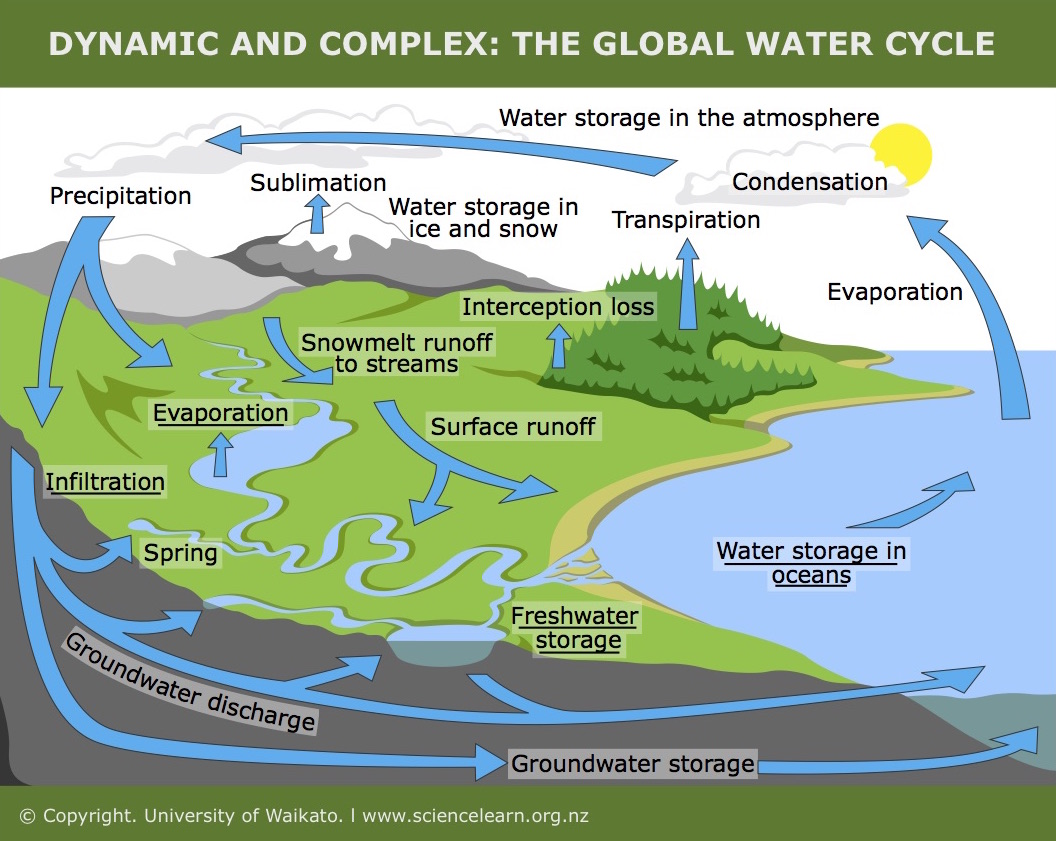There are many interacting systems that make up the Earth, many of which are dynamic. These notes discuss the importance of understanding the concept of systems with emphasis on the water cycle, and are aimed specifically for teachers.
What is the Earth system?
Scientists increasingly view Earth as a dynamic system – a combination of interrelated, interdependent or interacting parts forming a collective whole or entity. On a macro level, the Earth system maintains its existence and functions as a whole through the interactions of its parts, called components. At a lower level or micro level, it is helpful to think of the Earth system in terms of four central components known as the subsystems – the hydrosphere, geosphere, atmosphere and biosphere.
These subsystems are interconnected by processes and cycles, which, over time, intermittently store, transform and/or transfer matter and energy throughout the whole Earth system in ways that are governed by the laws of conservation of matter and energy. The energy that drives these processes comes mainly from the Sun and sometimes from energy sources within the Earth.
Examples of some of these processes include evaporation, erosion, convection currents, transpiration, photosynthesis or weathering. They can occur at different rates and in different places over time.
A cycle is a collection of connected, on-going processes that circulates a common component throughout a system – such cycles are continuous with no beginning or end. Examples in the Earth system include the rock cycle, the food chain, the carbon cycle, the nitrogen cycle, the water cycle and energy cycles.
Systems can be complex and dynamic, stable and unstable
Systems can range in complexity, and Earth’s subsystems are all dynamic. Key to understanding the complexity of the Earth system is that manipulation in one part of a subsystem can cause effects in other parts of that subsystem and/or the other subsystems, sometimes in ways that are quite unexpected. This response occurs because the subsystem attempts to maintain its stability, so if one variable changes, other variables may be affected to varying degrees.
This degree of response also describes how stable or unstable these systems are. For example, a glacier is a relatively unstable system – if the temperature in the atmosphere rises above the melting point of ice, the glacier melts and decreases in ice and the glacier retreats. In contrast, a tree is a relatively stable system that regulates environmental changes due to water shortage, for example, by reducing the size of its leaves’ stomata so it can return to a relative state of equilibrium.
On a bigger scale, the rising temperature in the atmosphere in a region can bring on a cascade of environmental changes to restore equilibrium across the subsystems, such as changes in evaporation and transpiration rates, weather patterns such as winds and precipitation, salinity of water bodies like lakes and seas, and type of species and numbers of organisms. Each response to a change can trigger a string of interconnected responses, which makes the repercussions of any single change in this complex and dynamic Earth system difficult to predict. Earth systems and climate change takes a closer look at this issue from scientific and te ao Māori perspectives.
The water cycle
The water cycle is the result of a collection of connected processes that distribute water and energy throughout the Earth system in cyclic patterns. Over time, on-going and repeated change in the distribution and form of water and energy around the globe is caused by processes like evaporation, condensation, freezing, melting, convection currents and infiltration.
Different smaller systems such as like clouds, plants, aquifers and seawater, play a part in the water cycle and influence how water is distributed. There are also cycles within cycles.
The distribution of water is also closely linked to the distribution of other forms of matter, particularly dissolved materials in rivers, lakes and groundwater. Human activity such as agriculture, irrigation, industrial processes, sea transport and sewage disposal can impact on the components and processes of the water cycle in a number of ways – consider the impact of power generation through hydroelectric dams, for example.
Teaching the Earth System and water cycle concepts
Research into students’ learning about the water cycle indicates that many students have an incomplete picture of the water cycle and hold alternative conceptions. Their thinking is often naïve, and few can recognise the complexities involved. Students may only represent the upper part of the water cycle (evaporation, condensation and rainfall) and ignore the ‘less visible’ groundwater, biospheric and environmental components.
Where groundwater is acknowledged, it is often seen as a static, unchanging component of the water cycle. Students may also struggle with water chemistry throughout the cycle – ideas about dissolving and purification through percolation and/or evaporation can be problematic. At times, students also underestimate the impact of human activities on the water cycle.
Before starting teaching the water cycle, students need to understand some of the basic scientific ideas underpinning the concept of the Earth system and its four subsystems. Students could engage in the activities Building a water cycle and Constructing an aquifer model, before tracing the many possible paths of an imaginary water molecule within the water cycle in order to identify relevant processes and components. Such an activity can also highlight the role of time in the cycle and teach students an appreciation that materials move at different rates at any given time.
An extension activity could be to learn more about parts of the water cycle and how it affects the subsystem of system Earth by exploring the article Humans and the water cycle.

